Quilting Foot: A Guide to the 15 Best Presser Feet for Quilting
Have you ever wondered, “What types of presser feet for quilting are the best?” Well, the answer lies in the versatility and precision offered by the quilting foot. While it might not come as a standard accessory with your sewing machine, it’s a valuable addition, particularly for quilting enthusiasts.
In this article, we delve into the world of quilting feet, unveiling the 15 best presser feet designed to elevate your quilting experience. From the essential Walking Foot to the creative Echo Quilting Foot, each snippet below introduces you to a presser foot that can revolutionize your quilting projects.
15 Best Quilting Feet
Here’s a list of the 15 Best Quilting Feet:
- Walking Foot (Even Feed Foot)
- Free-Motion Quilting Foot (Darning Foot)
- Quilting Guide Foot
- 1/4 Inch Quilting Foot
- Open-Toe Quilting Foot
- Edge Stitching Foot (Stitch-in-the-Ditch Foot)
- Ruler Foot
- Echo Quilting Foot
- Cording Foot
- Hopping (Spring-Loaded) Quilting Foot
- Monogramming Foot
- Binder Foot
- Adjustable Quilting Guide Foot
- Free-Motion Couching Foot
- Circle Stitching Foot
Embark on a journey of creativity and precision as we explore the functionality and benefits of these 15 best presser feet for quilting.
Tutorial on Quilting Feet
Understanding the distinction between the quilting foot, commonly mistaken for a walking foot or even-feed foot, is crucial for a seamless quilting experience. While these terms are sometimes used interchangeably, it’s essential to recognize their differences to enhance your quilting journey.
The walking foot excels at securing multiple layers of fabric, ensuring they stay aligned and move uniformly through the sewing machine in a straight trajectory. This foot is particularly useful for tasks that demand precise stitching along straight lines.
In contrast, the free-motion quilting foot offers a distinct advantage by not only holding multiple layers together but also allowing the fabric to pivot and be sewn in various directions. This flexibility is especially advantageous in the final stages of quilting when all the components are being pieced together. The quilting foot’s capacity for free-motion quilting grants quilters the liberty to move the fabric in any direction, contributing to the creation of intricate and dynamic quilt designs.
By grasping the unique features of the quilting foot and discerning its role in comparison to other feet, you equip yourself with the knowledge needed for a more relaxed and enjoyable quilting experience. The quilting foot becomes an invaluable tool, providing the freedom of movement essential for the intricate and creative aspects of quilting as you piece together the final elements of your quilt project.
Most Common Types of Quilting Foot
Quilting feet are specialized presser feet used with sewing machines to make quilting tasks more efficient and precise. Various quilting feet are available, each tailored to specific machine brands.
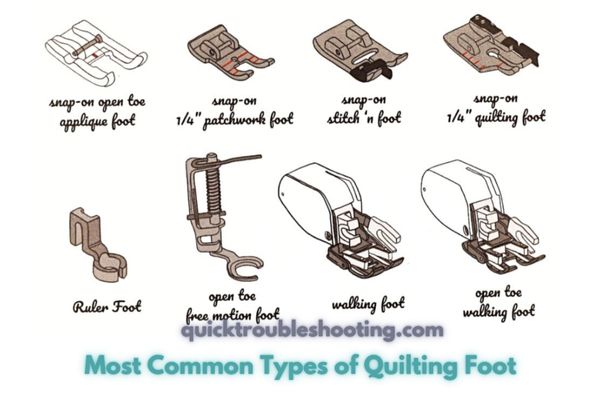
Additionally, various designs and attachments complement these feet. If you’re unsure about which attachment corresponds to a specific foot, refer to your machine manual’s sewing attachments list for clarification.
Here’s a concise table the key features and purposes of various quilting feet:
| Quilting Foot Type | Purpose and Features | Machine Compatibility |
|---|---|---|
| Walking Foot (Even Feed Foot) | – Evenly feeds multiple fabric layers. – Prevents shifting, ideal for quilting with batting. | Standard sewing machines |
| Free-Motion Quilting Foot | – Enables free movement in any direction. – Ideal for stippling, meandering, and free-motion designs. | Standard sewing machines |
| Quilting Guide Foot | – Equipped with a guide for maintaining consistent seam allowances. | Standard sewing machines |
| 1/4 Inch Quilting Foot | – Guides for maintaining a precise 1/4-inch seam allowance, common in quilting. | Standard sewing machines |
| Open-Toe Quilting Foot | – Provides better visibility for free-motion quilting. – Allows clear view of the stitching area. | Standard sewing machines |
| Edge Stitching Foot | – Helps sew accurately along seams or in the ditch between fabric pieces. | Standard sewing machines |
| Ruler Foot | – Designed for use with quilting rulers or templates. – Creates straight lines or geometric designs. | Standard sewing machines |
| Echo Quilting Foot | – Guides fabric at a consistent distance from previous stitching, creating echo effects. | Standard sewing machines |
| Cording Foot | – Used for adding decorative cords or piping to quilt projects. | Standard sewing machines |
| Hopping (Spring-Loaded) Foot | – Designed for long-arm quilting machines. – Allows the foot to “hop” over seams and uneven surfaces. | Long-arm quilting machines |
| Monogramming Foot | – Useful for adding monograms or decorative stitches to quilted projects. | Standard sewing machines |
| Binder Foot | – Facilitates attachment of bias binding to quilt edges. | Standard sewing machines |
| Adjustable Quilting Guide Foot | – Provides flexibility in adjusting the distance from the needle to the fabric for various seam allowances. | Standard sewing machines |
| Free-Motion Couching Foot | – Enables couching yarn or decorative threads onto the fabric during free-motion quilting. | Standard sewing machines |
| Circle Stitching Foot | – Designed for creating perfect circles or arcs in quilting designs. | Standard sewing machines |
Here are some of the most common types of presser feet for quilting:
Walking Foot (Even Feed Foot)
The walking foot, also known as the even feed foot, emerges as a pivotal accessory in quilting due to its purposeful design.
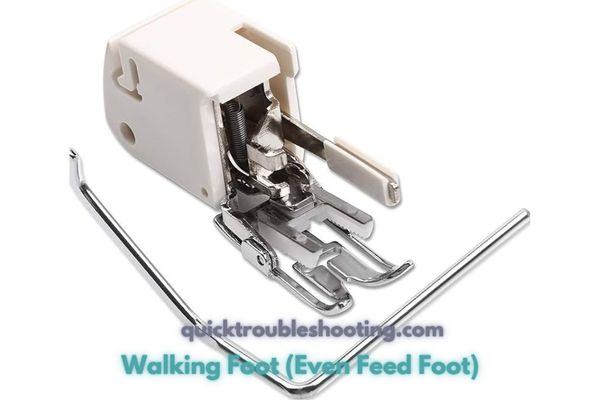
Specifically engineered to facilitate the seamless feeding of multiple layers of fabric, this foot plays a crucial role in preventing undesirable shifts between layers. Its significance becomes particularly pronounced when quilting with batting, where uniformity and stability are paramount.
By evenly advancing layers of fabric through the machine, the walking foot contributes to the creation of meticulously crafted quilts characterized by precise stitching and alignment.
Free-Motion Quilting Foot (Darning Foot)
In stark contrast to the structured guidance provided by the walking foot, the free-motion quilting foot, often referred to as the darning foot, empowers the quilter with a liberating range of movement. This foot allows fabric to be maneuvered freely in any direction, opening up avenues for creative expression in quilting.
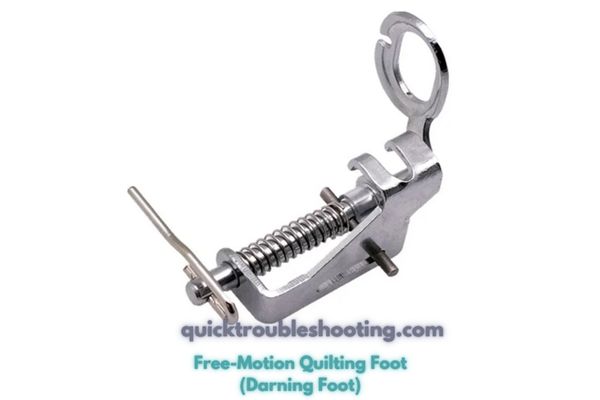
Ideal for techniques such as stippling and meandering, the free-motion quilting foot transforms the sewing machine into a versatile tool for crafting intricate and artistic designs. Whether pursuing abstract patterns or elaborate free-form motifs, this foot provides the necessary flexibility to bring unique quilting visions to life.
Quilting Guide Foot
The Quilting Guide Foot stands as a precision tool designed to elevate the accuracy of quilting endeavors. Equipped with a guide, this foot serves a crucial role in maintaining consistent seam allowances during the quilting process. The guide, often adjustable, ensures that the distance between the needle and the fabric’s edge remains uniform.
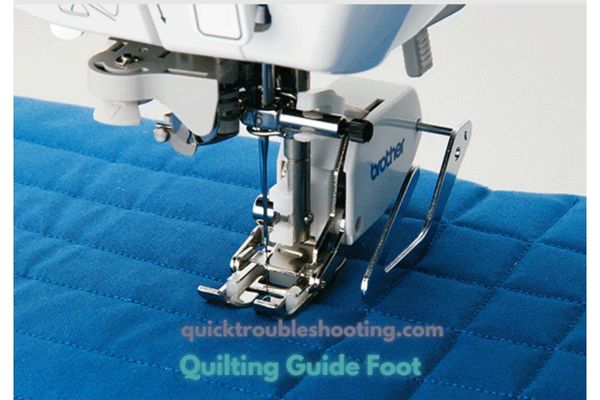
As a result, quilters can achieve impeccably measured seams, contributing to the overall cohesion and professional finish of quilting projects. This foot is particularly valuable for intricate quilt patterns and projects that demand meticulous attention to detail.
1/4 Inch Quilting Foot
The 1/4 Inch Quilting Foot emerges as a quintessential accessory in the quilter’s toolkit, specifically engineered to address the common practice of maintaining a precise 1/4-inch seam allowance. This particular seam allowance is widely embraced in quilting due to its role in preserving the structural integrity of quilt blocks and facilitating ease in joining components.
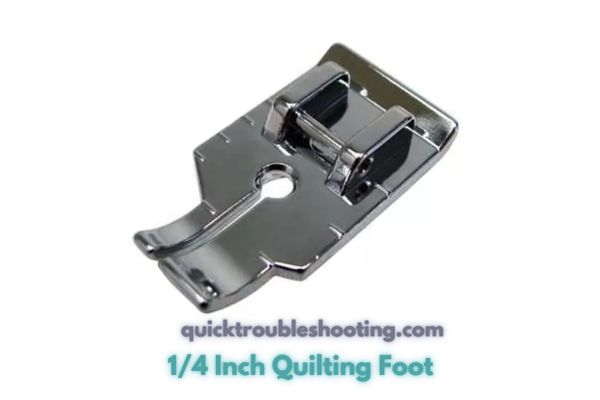
The 1/4 Inch Quilting Foot features a guide that ensures the fabric’s edge consistently aligns with the desired measurement, promoting accuracy and efficiency in piecing together quilt elements. Quilters often rely on this foot to achieve the coveted precision characteristic of well-crafted quilts.
Open-Toe Quilting Foot
The Open-Toe Quilting Foot introduces a distinctive design element that significantly enhances visibility during free-motion quilting endeavors. Recognizing the importance of clear sightlines in intricate stitching, this foot features an open front, allowing quilters an unobstructed view of the stitching area.
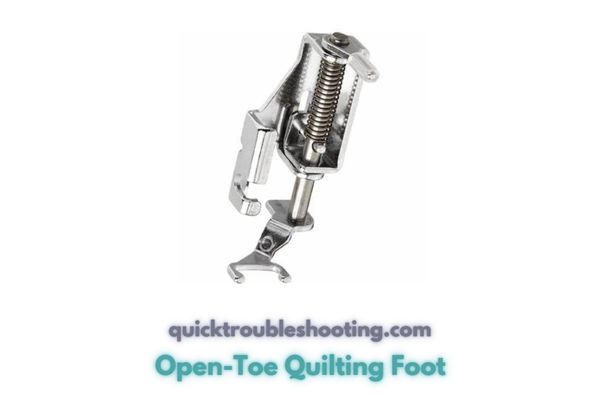
This heightened visibility proves invaluable when executing free-motion quilting techniques such as stippling, meandering, or other creative designs. By providing a clear line of sight, the Open-Toe Quilting Foot empowers quilters to exercise greater control over their stitch patterns, fostering artistic expression and precision in every stitch.
Edge Stitching Foot (Stitch-in-the-Ditch Foot)
The Edge Stitching Foot, also known as the Stitch-in-the-Ditch Foot, is a specialized attachment tailored for precision along seams or in the ditch between fabric pieces. This foot features a guide or blade that aligns with the seams, enabling quilters to sew accurately along these lines.
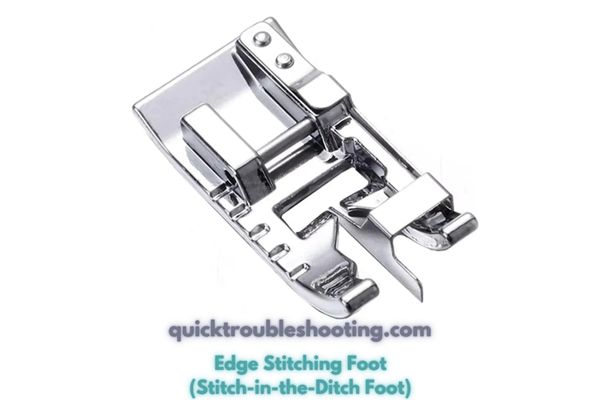
This level of precision is particularly valuable for projects where maintaining a seamless and inconspicuous appearance along seam lines is crucial. Whether creating quilted borders or joining fabric pieces seamlessly, the Edge Stitching Foot ensures a professional finish by minimizing deviation from the intended stitching path.
Ruler Foot
The Ruler Foot is a dynamic accessory designed to enhance quilting precision by incorporating quilting rulers or templates. Quilters can attach rulers or templates to the foot, providing a guided path for the needle to follow. This foot is particularly useful for creating straight lines, sharp angles, or intricate geometric designs in quilting projects.
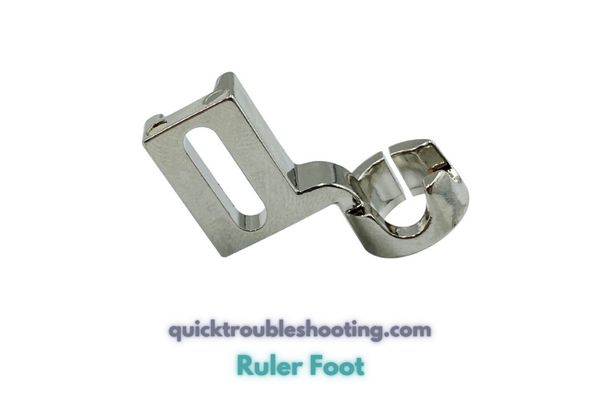
The Ruler Foot empowers quilters to achieve a level of accuracy and intricacy that may be challenging with free-motion quilting alone. It opens up possibilities for creating visually stunning and precisely executed quilt patterns.
Echo Quilting Foot
The Echo Quilting Foot is a versatile tool that facilitates the creation of captivating echo quilting effects. This foot features a guide that helps maintain a consistent distance from the previous stitching line as the quilter moves the fabric. The result is a series of parallel lines or curves that echo the contour of the initial stitching.
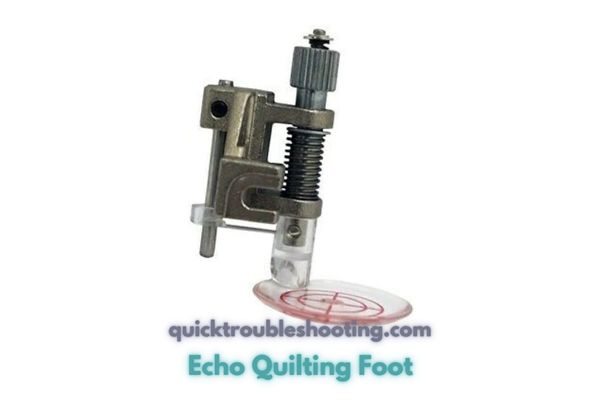
Quilters often use this foot to add texture and dimension to their projects, creating visually appealing patterns that enhance the overall aesthetic of the quilt. Whether employed for background quilting or as a design element in its own right, the Echo Quilting Foot adds depth and intricacy to quilting projects.
Cording Foot
The Cording Foot is a specialized attachment designed to add a touch of elegance and dimension to quilt projects by incorporating decorative cords or piping. This foot typically features a groove or channel that accommodates the cord while stitching, ensuring its secure placement within the quilt seam.
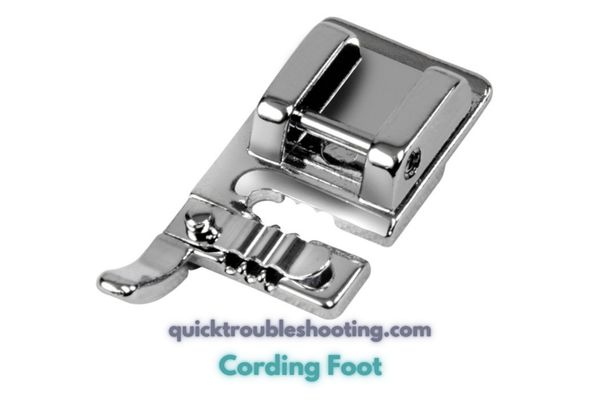
Quilters can experiment with different cord materials, colors, and thickness to create unique embellishments that enhance the visual appeal of their quilts. The Cording Foot adds a decorative and textural element to quilted projects, allowing for creative expression and customization.
Hopping (Spring-Loaded) Quilting Foot
The Hopping Quilting Foot is engineered for use with long-arm quilting machines, offering a unique functionality essential for navigating uneven surfaces and seams. Unlike traditional presser feet, the Hopping Foot is spring-loaded, allowing it to “hop” or move vertically as the machine moves horizontally. This design enables the foot to glide smoothly over fabric layers, seams, and other irregularities.

Quilters using long-arm machines benefit from the Hopping Quilting Foot’s ability to maintain consistent stitch quality even when quilting over multiple layers or challenging terrain. It ensures precision and uniformity in quilting, contributing to the professional finish of larger quilting projects.
Monogramming Foot
The Monogramming Foot is a versatile attachment that proves invaluable for adding personalized touches to quilted projects. Designed to accommodate decorative stitches and monogramming, this foot allows quilters to infuse their creations with unique lettering or intricate designs.
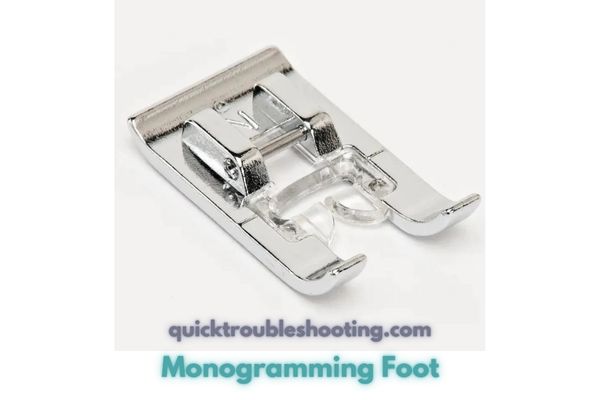
The Monogramming Foot often provides enhanced visibility of the stitching area, enabling precise placement of monograms and decorative elements. Whether adding a personal touch to quilt labels, commemorating special occasions, or incorporating intricate patterns, this foot empowers quilters to infuse their projects with individuality and sentiment.
Binder Foot
The Binder Foot is a specialized quilting foot designed to streamline the process of attaching bias binding to the edges of quilts. This foot features a channel that accommodates the binding tape, ensuring precise alignment and stitching along the quilt’s perimeter.

Quilters benefit from the Binder Foot’s ability to securely attach bias binding, providing a clean and professional finish to quilt edges. This foot is particularly valuable for quilters seeking a polished and durable edge treatment, enhancing both the appearance and longevity of their quilted creations.
Adjustable Quilting Guide Foot
The Adjustable Quilting Guide Foot stands out for its adaptability, offering quilters the flexibility to customize the distance from the needle to the fabric’s edge. This adjustability proves crucial for achieving various seam allowances, catering to the specific requirements of different quilting projects.
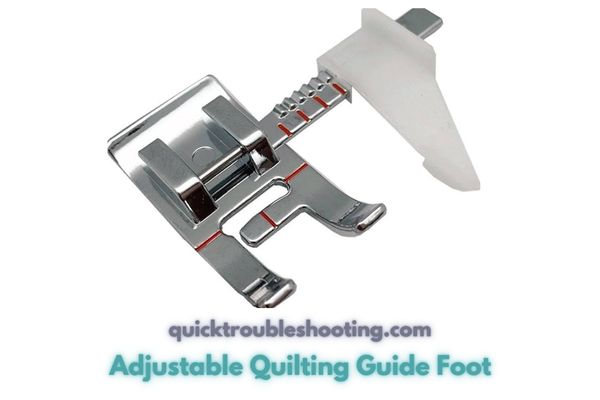
The guide on this foot assists in maintaining consistent seam widths, ensuring precision in stitching. Quilters can effortlessly adapt to diverse fabric thicknesses and project specifications, making the Adjustable Quilting Guide Foot a versatile tool for achieving professional results in quilting.
Free-Motion Couching Foot
The Free-Motion Couching Foot is a creative addition to the quilter’s toolkit, empowering users to add texture and dimension to their projects. This foot facilitates the process of couching, where yarn or other decorative threads are attached to the fabric during free-motion quilting.
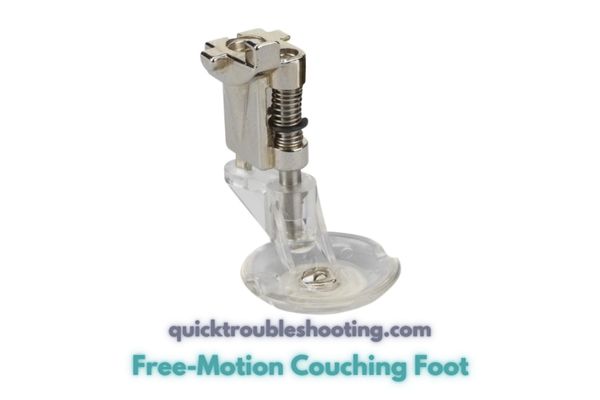
Quilters can experiment with various yarn types and thicknesses, creating unique patterns and embellishments. The Free-Motion Couching Foot enhances artistic expression in quilting, allowing for the incorporation of decorative elements that elevate the visual appeal of quilted designs.
Circle Stitching Foot
The Circle Stitching Foot is tailored for the precise creation of perfect circles or arcs in quilting designs. This foot often features a guide or pivot point that enables quilters to stitch circular patterns with ease and accuracy.
Whether crafting circular motifs as standalone features or incorporating them into larger quilt designs, the Circle Stitching Foot facilitates the creation of geometrically precise shapes. Quilters can experiment with different circle sizes, adding a dynamic and visually engaging element to their quilting projects.
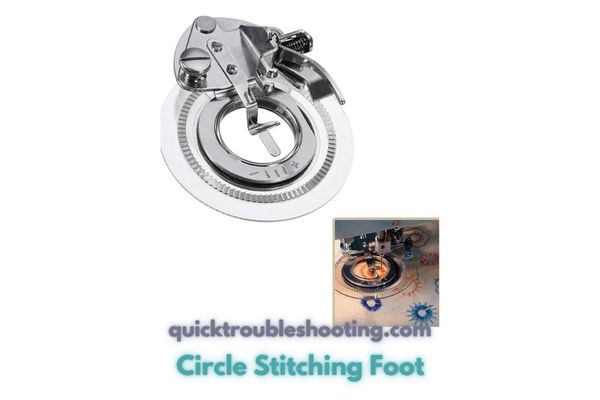
It’s important to note that the availability of these quilting feet may vary depending on the sewing machine brand and model. To ensure compatibility, quilters should consult their sewing machine manual or manufacturer guidelines. Selecting the right quilting foot for your specific machine enhances your quilting experience, enabling you to achieve professional results in your projects.
Here’s a table of various quilting feet:
| Quilting Foot Type | Purpose and Features | Machine Compatibility |
|---|---|---|
| Walking Foot (Even Feed Foot) | – Evenly feeds multiple fabric layers. – Prevents shifting, ideal for quilting with batting. | Standard sewing machines |
| Free-Motion Quilting Foot | – Enables free movement in any direction. – Ideal for stippling, meandering, and free-motion designs. | Standard sewing machines |
| Quilting Guide Foot | – Equipped with a guide for maintaining consistent seam allowances. | Standard sewing machines |
| 1/4 Inch Quilting Foot | – Guides for maintaining a precise 1/4-inch seam allowance, common in quilting. | Standard sewing machines |
| Open-Toe Quilting Foot | – Provides better visibility for free-motion quilting. – Allows clear view of the stitching area. | Standard sewing machines |
| Edge Stitching Foot | – Helps sew accurately along seams or in the ditch between fabric pieces. | Standard sewing machines |
| Ruler Foot | – Designed for use with quilting rulers or templates. – Creates straight lines or geometric designs. | Standard sewing machines |
| Echo Quilting Foot | – Guides fabric at a consistent distance from previous stitching, creating echo effects. | Standard sewing machines |
| Cording Foot | – Used for adding decorative cords or piping to quilt projects. | Standard sewing machines |
| Hopping (Spring-Loaded) Foot | – Designed for long-arm quilting machines. – Allows the foot to “hop” over seams and uneven surfaces. | Long-arm quilting machines |
| Monogramming Foot | – Useful for adding monograms or decorative stitches to quilted projects. | Standard sewing machines |
| Binder Foot | – Facilitates attachment of bias binding to quilt edges. | Standard sewing machines |
| Adjustable Quilting Guide Foot | – Provides flexibility in adjusting the distance from the needle to the fabric for various seam allowances. | Standard sewing machines |
| Free-Motion Couching Foot | – Enables couching yarn or decorative threads onto the fabric during free-motion quilting. | Standard sewing machines |
| Circle Stitching Foot | – Designed for creating perfect circles or arcs in quilting designs. | Standard sewing machines |
Quilting Foot vs. Walking Foot: Unveiling the Contrasts
Understanding the disparities between the quilting foot and the walking foot is pivotal for quilters seeking precision and versatility in their projects. Here are four fundamental distinctions to consider:
Direction of Fabric Feed:
- Quilting Foot: Enables the quilter to feed the fabric through the machine in various directions, allowing for free-motion quilting and embroidery.
- Walking Foot: Primarily designed for straight-line sewing, limiting the fabric feed to a single direction.
Applications in Quilting:
- Quilting Foot: Tailored for free-motion embroidered pieces and free-motion quilting, offering flexibility in stitching patterns.
- Walking Foot: Ideal for stitching multiple layered quilts, especially those challenging to sew in a straight direction, such as when dealing with numerous layers of fabric.
Cost Considerations:
- Quilting Foot: Generally more affordable to purchase, making it a budget-friendly option for quilters.
- Walking Foot: Tends to be more expensive than the quilting foot, reflecting its specialized features and capabilities.
Effects on Quilted Projects:
- Quilting Foot: Introduces interesting textured effects to quilted projects through free-motion techniques.
- Walking Foot: Primarily focused on maintaining accuracy in quilt layers, securing them in place during straight-line stitching. Its emphasis is on precision and stability.
Comparison Table: Quilting Foot vs. Walking Foot
| Feature | Quilting Foot | Walking Foot |
|---|---|---|
| Direction of Fabric Feed | Allows various directions for free-motion work. | Primarily facilitates straight-line sewing. |
| Applications in Quilting | Suited for free-motion embroidery and quilting. | Ideal for stitching challenging layered quilts. |
| Cost Considerations | Generally more affordable. | Tends to be more expensive. |
| Effects on Quilted Projects | Creates textured effects with free-motion. | Emphasizes accuracy and stability. |
By weighing these differences, quilters can make informed decisions based on the specific requirements of their projects. The choice between the quilting foot and walking foot depends on the desired stitching techniques, project complexity, and budget considerations.
Using A Quilting Foot: Mastering the Art of Quilting with a Quilting Foot
Once you’ve successfully configured your quilting sewing foot, it’s time to elevate your quilting game by exploring various techniques and movements. Beyond the basics of straight and wavy lines, embracing additional stitching techniques can transform your quilting projects into works of art.
Here’s an in-depth look at two key techniques and some extra tips to enhance your quilting experience:
Perfecting Traveling: Enhancing Line Emphasis
A fundamental technique to explore with your quilting foot is known as traveling. This method involves stitching over previously stitched lines a second time, strategically emphasizing specific lines within your quilt. Quilters employ traveling to bring out the qualities of a pattern or to create a distinctive visual impact.
As you move your quilting foot over the existing stitches, you’ll notice how this technique accentuates certain elements, adding depth and definition to your quilt. By mastering traveling, you can effectively control the emphasis and overall aesthetics of your quilting designs.
Embracing Meandering: Artful Randomness
Meandering introduces a captivating and unconventional approach to quilting. With this technique, you allow your sewing machine, guided by the quilting foot, to wander randomly across the quilt surface. While meandering doesn’t adhere to a specific pattern, the resulting swirls and twirls create visually intriguing effects.
Not only does meandering add an artistic flair to your quilts, but it also serves a practical purpose by effectively securing the layers of the quilt together. This technique, made possible with the precision of a quilting foot, encourages creativity and experimentation, fostering a unique aesthetic in your quilting projects.
Stitch-in-the-Ditch: Seam-Perfect Precision
Stitch-in-the-Ditch is a technique that emphasizes precision by quilting directly along the seams of your pieced quilt blocks. This method ensures a seamless and integrated appearance, allowing the quilting stitches to nestle discreetly within the natural lines of your quilt.
Stitching in the ditch not only provides a polished finish but also highlights the intricate piecing work, creating a cohesive and professional look for your quilt. The quilting foot plays a crucial role in guiding your stitches with accuracy along these seams, making this technique an essential addition to your quilting repertoire.
Echo Quilting: Captivating Dimensionality
Echo Quilting is a technique that introduces captivating dimensionality to your quilting patterns. With the aid of the quilting foot, maintain a consistent distance from previous stitching lines, creating echoes around your chosen design elements.
This method adds depth and texture to your quilts, making the patterns stand out with a visually striking effect. Whether accentuating appliqué motifs or enhancing geometric shapes, mastering echo quilting with your quilting foot offers a versatile tool for creative expression and design enhancement.
Cross-Hatching: Timeless Elegance in Grids
Cross-Hatching is a classic quilting technique that imparts timeless elegance to your projects. Achieved by quilting a grid of straight lines, either diagonally or perpendicularly, this method adds structure and sophistication to your quilt design.
The quilting foot’s precise guidance ensures that the lines intersect with accuracy, creating a balanced and cohesive appearance. Cross-hatching is particularly effective for highlighting specific areas of your quilt or providing a backdrop that complements intricate quilt motifs, showcasing a level of craftsmanship that transcends time.
Stippling: Dynamic Texture with Free-Motion Artistry
Stippling is a free-motion quilting technique that invites dynamic texture and visual interest into your quilts. With the freedom of movement facilitated by the quilting foot, create a random, non-repetitive pattern across the quilt’s surface.
Stippling adds an organic and handcrafted quality to your projects, breaking away from structured patterns and allowing for artistic spontaneity. This technique enhances the tactile and visual appeal of your quilts, making each piece a unique and expressive work of art.
In your journey towards quilting mastery, the exploration of these advanced techniques, coupled with the precision of your quilting foot, opens up a realm of creative possibilities. As you experiment with these methods, you’ll discover the joy of crafting quilts that not only showcase your technical skill but also reflect your artistic vision and individuality. Happy quilting!
Conclusion: Quilting Foot for Sewing Machine
In conclusion, understanding the distinctions between the quilting foot and the walking foot is essential for quilters aiming to enhance their craft. The quilting foot offers versatility in fabric feed, making it suitable for free-motion techniques, while the walking foot excels in straight-line sewing and layered quilt projects.
Considerations such as cost and the desired effects on quilted projects further guide the choice between these two specialized tools. By making informed decisions based on individual project needs, quilters can unlock the full potential of these feet, elevating the artistry and precision of their quilting endeavors.
